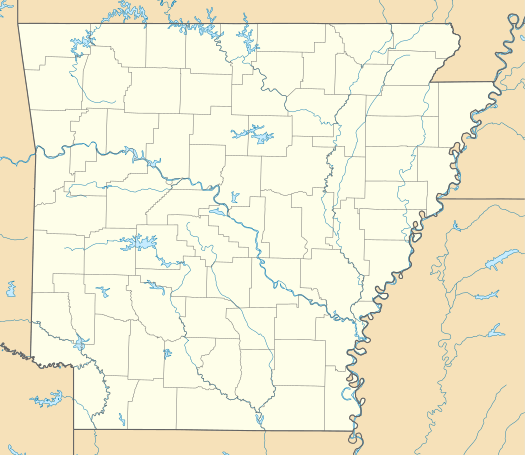Confederate State Capitol building (Arkansas)
The Confederate State Capitol building in Washington, Arkansas was the capital of the Confederate state government of Arkansas, during 1863–1865, after Little Rock, Arkansas fell to Union forces in the American Civil War. It is located within Historic Washington State Park, and is a National Historic Landmark.
Confederate State Capitol | |
Front of the Capitol | |
  | |
| Location | Washington, Arkansas |
|---|---|
| Coordinates | 33°46′43″N 93°40′41″W |
| Built | 1836 |
| Architect | Patterson, Tillman L. |
| Architectural style | Greek Revival |
| Part of | Washington Historic District (ID72000204) |
| NRHP reference No. | 72000203[1] |
| Significant dates | |
| Added to NRHP | May 19, 1972[1] |
| Designated NHL | April 19, 1994[2] |
| Designated CP | June 20, 1972 |
Description and history
The capitol building is a two-story wood frame structure, about 44 feet (13 m) wide and 34 feet (10 m) deep, resting on a brick foundation. It is topped by a hip roof covered in cedar shakes. Each of the two floors is dominated by a large chamber; that on the ground floor originally served as a courtroom, while that on the upper floor was used by local Masonic societies. The original front entrance is sheltered by a single-story portico with a triangular pediment with Greek Revival styling. There are chimneys on the two sides of the building.[3]
The building was erected in 1836, and was Hempstead County's second courthouse, replacing an 1824 log structure. The building served as the county court until 1874, when a new brick building was constructed. After the fall of Little Rock to Union Army forces in September 1863, during the American Civil War, Governor Harris Flanagin ordered the seat of government relocated to Washington. The Confederate state government would remain in this building until the end of the war in 1865.[3]
After the court functions moved out in 1874, the building was repurposed for use as a school, a role it fulfilled until 1914. It thereafter served as a private residence until 1928, when it was acquired by the state through the efforts of the local United Daughters of the Confederacy chapter. It is now part of Historic Washington State Park.[3]
The building was listed on the National Register of Historic Places in 1970, and, with other sites, was designated part of the Camden Expedition Sites National Historic Landmark District in 1994.[2][4][5]
See also
References
- "National Register Information System". National Register of Historic Places. National Park Service. January 23, 2007.
- "Camden Expedition Sites". National Historic Landmark summary listing. National Park Service. 2007-09-26. Archived from the original on 2007-03-01.
- "NRHP nomination for Confederate State Capitol" (PDF). Arkansas Preservation. Retrieved 2014-09-15.
- ""Camden Expedition Sites", November 29, 1993, by Edward C. Bearss and James H. Charleton" (pdf). National Park Service. 1993-11-29. National Historic Landmark Nomination
- "Camden Expedition Sites--Accompanying 62 photos, from 1992-1993: Old U.S. Arsenal (6 photos), Confederate State Capitol (5 photos), Prairie de Ann Battlefield (7 photos), Jenkins' Ferry Battlefield (4 photos), Marks' Mills Battlefield (10 photos), Fort Southerland (5 photos), Poison Spring Battlefield (7 photos), Fort Lookout (9 photos), Elkin's Ferry Battlefield (9 photos)" (pdf). National Park Service. 1993-11-29. National Register of Historic Places Inventory-Nomination